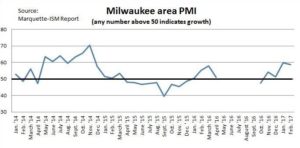Southeastern Wisconsin’s manufacturing sector continued to expand in February, but the latest Marquette-ISM Report on Manufacturing shows some signs of slowing growth.
The report’s seasonally adjusted Milwaukee-area PMI dropped slightly in February to 58.69. Any reading above 50 indicates expansion in the sector. January’s 59.81 reading was the highest since November 2014.

Respondent comments in the report reflected a mix of challenges including fluctuating production, large orders creating bottlenecks, and rising commodity prices in some situations.
Multiple respondents noted rising wages, particularly for qualified employees, while others said employment would remain the same. The blue collar employment index remained in positive territory, but declined from 55.4 in January to 52.5 in February. The white collar index had an even sharper drop from 55.3 to 50.2.
The overall outlook for business conditions in the next six months declined slightly. The percent expecting improved positive conditions declined from 58.07 to 50 percent, while those expecting worse conditions dropped from 9.68 to 5 percent. The percentage expecting the same conditions increased from 32.26 to 45 percent. As a result, the report’s diffusion index declined from 74.19 to 72.5 percent. The index attempts to eliminate bias towards positive or negative responses.
A majority of the other measures in the report were either flat or down during the month, but all remained in positive territory. Those declining included new orders, (down 2.7 to 62.76), employment (down 6.1 to 52.48), supplier deliveries (down 4.1 to 58.39) and imports (down 1 to 61.54). Inventories and customer inventories were both flat at 50 and 37.5 respectively.
Measures increasing during February include production (up 7.3 to 69.83), prices (up 8.5 to 81.82), backlog (up 1.5 to 61.11) and exports (up 1.1 to 53.57).
Lead times for capital expenditures increased by 23 days to 100 days and production material lead times were up 21 days to 54 days. Lead times for maintenance, repair and operating supplies remained at 20 days.
Read more economic data reports at the BizTracker page.